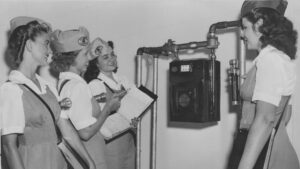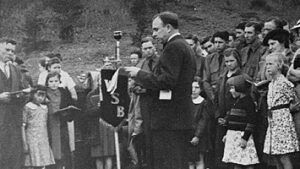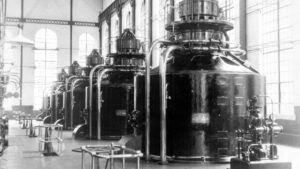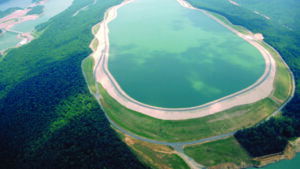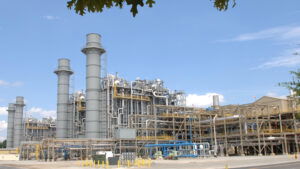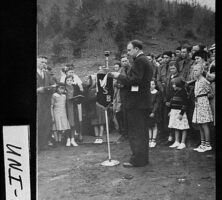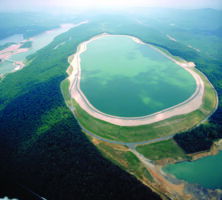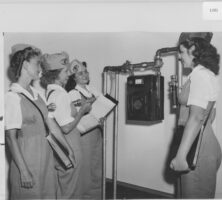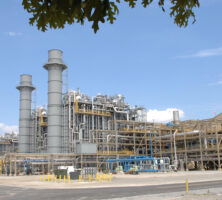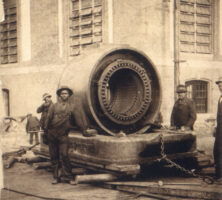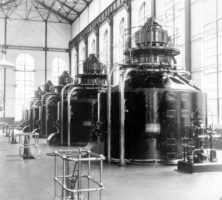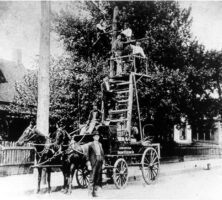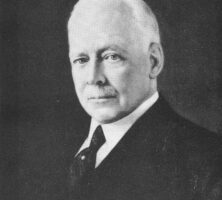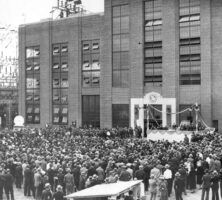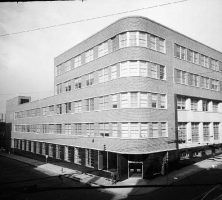The New Georgia Encyclopedia is supported by funding from A More Perfect Union, a special initiative of the National Endowment for the Humanities.
E. D. Rivers speaks in 1939, during his second gubernatorial term, at a gathering in Union County, located in the north Georgia mountains. During his first term, Rivers secured federal funding to support public housing and rural electrification in the state.
Courtesy of Georgia Archives, Vanishing Georgia, #uni005.
The New Georgia Encyclopedia does not hold the copyright for this media resource and can neither grant nor deny permission to republish or reproduce the image online or in print. Requests for permission to publish or reproduce the resource should be submitted to the Georgia Archives.
The upper reservoir of the Rocky Mountain Hydroelectric Plant, located in Floyd County, holds water to be released into a powerhouse that generates electricity. The plant is jointly owned by Oglethorpe Power Corporation and Georgia Power Company.
Courtesy of Oglethorpe Power Corporation
The New Georgia Encyclopedia does not hold the copyright for this media resource and can neither grant nor deny permission to republish or reproduce the image online or in print. All requests for permission to publish or reproduce the resource must be submitted to the rights holder.
Oglethorpe Power Corporation, headquartered in DeKalb County, was founded through U.S. president Franklin D. Roosevelt's Rural Electrification Administration, which was established in 1935. As of 2011, Oglethorpe Power was the nation's largest electric power cooperative, serving 4.1 million customers in Georgia.
Courtesy of Oglethorpe Power Corporation
The New Georgia Encyclopedia does not hold the copyright for this media resource and can neither grant nor deny permission to republish or reproduce the image online or in print. All requests for permission to publish or reproduce the resource must be submitted to the rights holder.
The New Georgia Encyclopedia does not hold the copyright for this media resource and can neither grant nor deny permission to republish or reproduce the image online or in print. All requests for permission to publish or reproduce the resource must be submitted to the rights holder.
Employees of Atlanta Gas Light learn to read gas meters in 1942. During World War II, almost half of the company's workforce left to serve in the military, and women were hired to continue providing service to Atlanta Gas Light's customers, which grew to more than 123,000 by 1945.
Courtesy of AGL Resources
The New Georgia Encyclopedia does not hold the copyright for this media resource and can neither grant nor deny permission to republish or reproduce the image online or in print. All requests for permission to publish or reproduce the resource must be submitted to the rights holder.
Atlanta Gas Light Company, founded in 1856, today is a division of AGL Resources, a distributor of natural gas. Headquartered in Atlanta, AGL Resources operates six utility companies, including Atlanta Gas Light, in six states.
Courtesy of AGL Resources
The New Georgia Encyclopedia does not hold the copyright for this media resource and can neither grant nor deny permission to republish or reproduce the image online or in print. All requests for permission to publish or reproduce the resource must be submitted to the rights holder.
Located in Effingham County, the McIntosh Combined Cycle Plant began operation in June 2005 under the joint ownership of Savannah Electric and Power Company and Georgia Power, both subsidiaries of the Southern Company. In 2006 Savannah Electric merged into Georgia Power.
Courtesy of Savannah Electric and Power Company
The New Georgia Encyclopedia does not hold the copyright for this media resource and can neither grant nor deny permission to republish or reproduce the image online or in print. All requests for permission to publish or reproduce the resource must be submitted to the rights holder.
The generator end of a turbine is moved to the Riverside Plant of the Savannah Power Company in 1913. The plant was built one year earlier to serve the company's approximately 3,400 customers.
Courtesy of Savannah Electric and Power Company
The New Georgia Encyclopedia does not hold the copyright for this media resource and can neither grant nor deny permission to republish or reproduce the image online or in print. All requests for permission to publish or reproduce the resource must be submitted to the rights holder.
Generation units at the Tallulah Falls hydroelectric plant, an early facility of the Georgia Railway and Power Company.
Courtesy of Georgia Power Corporation Archives
The New Georgia Encyclopedia does not hold the copyright for this media resource and can neither grant nor deny permission to republish or reproduce the image online or in print. All requests for permission to publish or reproduce the resource must be submitted to the rights holder.
A horse-drawn line truck, pictured circa 1902, of the Georgia Railway and Electric Company.
Courtesy of Georgia Power Corporation Archives
The New Georgia Encyclopedia does not hold the copyright for this media resource and can neither grant nor deny permission to republish or reproduce the image online or in print. All requests for permission to publish or reproduce the resource must be submitted to the rights holder.
The New Georgia Encyclopedia does not hold the copyright for this media resource and can neither grant nor deny permission to republish or reproduce the image online or in print. All requests for permission to publish or reproduce the resource must be submitted to the rights holder.
Henry M. Atkinson became the majority stockholder and head of Georgia Electric Light Company in 1891. In 1902 Atkinson consolidated a number of businesses into Georgia Railway and Electric Company.
Courtesy of Georgia Power Corporation Archives
The New Georgia Encyclopedia does not hold the copyright for this media resource and can neither grant nor deny permission to republish or reproduce the image online or in print. All requests for permission to publish or reproduce the resource must be submitted to the rights holder.
Plant Atkinson on the Chattahoochee River in Cobb County was dedicated in 1930 and was Georgia Power Company's first modern steam plant.
Courtesy of Georgia Power Corporation Archives
The New Georgia Encyclopedia does not hold the copyright for this media resource and can neither grant nor deny permission to republish or reproduce the image online or in print. All requests for permission to publish or reproduce the resource must be submitted to the rights holder.
The Georgia Power Building in downtown Atlanta, designed by Heery Architects and Engineers, houses the headquarters for both the Georgia Power Company and the Georgia Power Foundation. In 2004 the Georgia Power Foundation awarded $5 million in grants to organizations primarily in the state of Georgia.
Image from Counse
The New Georgia Encyclopedia does not hold the copyright for this media resource and can neither grant nor deny permission to republish or reproduce the image online or in print. All requests for permission to publish or reproduce the resource must be submitted to the rights holder.
A four-story brick structure with a curved apex, the Atlanta Constitution Building was designed by Tucker and Howell and built by Atlanta firm Robert and Company in 1947. The building originally housed the offices of the Atlanta Constitution, but was occupied by Georgia Power Company from 1955 until 1972. It was one of the earliest moderne style buildings in Atlanta.
Courtesy of Special Collections & Archives, Georgia State University Library, Atlanta Journal-Constitution Photographic Archive.
The New Georgia Encyclopedia does not hold the copyright for this media resource and can neither grant nor deny permission to republish or reproduce the image online or in print. Requests for permission to publish or reproduce the resource should be submitted to Special Collections and Archives at Georgia State University.
